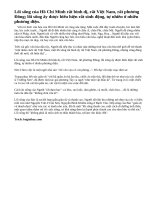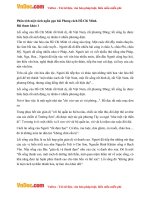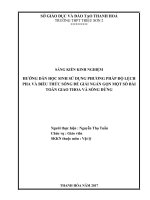bai 3-12 ngan gon
Bạn đang xem bản rút gọn của tài liệu. Xem và tải ngay bản đầy đủ của tài liệu tại đây (212.08 KB, 14 trang )
Preparing date: Sept, 2
nd
08 Teaching date: Sept, 3
rd
08. Period division: 13
th
Unit 3: Ways of socialising
Lesson A - Reading
I. Aims :
By the end of the lesson, students will:
- read for specific information about The ways of socialising.
- be able to talk some back ground information of The ways of socialising.
- Give the Vietnamese equivalents to the following words and phrases.
Decide which of the three options below is the best title for the passage and answer the
questions of the lesson.
II. Teaching aids:
textbook, pictures, cassette, tape, handouts and real objects
III. Procedure:
Stages T’s activities Sts’ activities
Warmer
5’
Jumbled words
- Write the words whose letters are in a random order on the
board.
- Divide the class into two teams. Ss from two teams go to the
board and write the correct words.
- The team which writes correct words first will be the winner.
1. osiacsilgin 2. fo 3. sawy
Answer : 1 socialising , 2 of , 3 ways
- Have Ss guess the phrase of words above
Ways of socialising
- Lead in: T asks Ss to open the textbook on page 31.
T: Today we are going to learn Unit 3- Ways of socializing
--> A: Reading
Team class
Before
reading
14’
- Ask students to look at the pictures, work in pairs to ask and
answer the questions
1. What are the people in the picture doing?
2. Can you guess what they say to each other?
3. What will you do / say if:
+ you want to get your teacher’s attention in class?
+ you need to ask someone a question, but they are busy
talking to someone else?
-Go around to offer help.
-Call on some Ss to present their answers and elicits
comments from other Ss. Give feedback if necessary
1.In the pictures, people are shaking hands and waving with
each other.
2.they may be greeting each other
Individual/
Pairs work
Quy Chau Upper Secondary School – Giao an co ban khoi 12
3. - If we want to get our teacher’s attention in class, we can
raise our hands slightly.
- If we need to ask someone a question, but they are busy
talking to someone else, we can…
* Teaching Vocabulary:
- T asks Ss to skim the passage and underline the new words.
- T explains the new words.
- attract (v)
- assistance(n)
- whistle (v)
- clap (v)
- attention (n)
- acceptable (a)
- Compliment: (n): (synonym)
- Decent: ( adj) (situation)
- Appropriate: ( adj) ( translation)
- Kidding(n) ( situation)
- Signal (n): ( example)
- Marvellous: ( adj): ( synonym)
* Ask Ss to give the Vietnamese equivalent (if necessary).
* Checking technique: Rub out & remember
While
reading
7’
Task 1
T writes these words on the board:
-Ask Ss to give the Vietnamese equivalent to the following
words and phrases.
-Instruct Ss to read the passage quickly and stop at the words
to guess their meanings.
-Guess the meaning of the words based on the context in the
sentences.
-Check that Ss understand the word correctly.
-Call some students to give the answers.
- Ask others students to correct.
- Give the true answers..
Present answers
- verbal (a): b»ng lêi, h÷u ng«n
- non-verbal (a); kh«ng b»ng lêi, phi ng«n
- attract someone’s attention: thu hut sù chó ý cña ai
- impolite (a) # polite (a): kh«ng lÞch sù
- rude(a) # polite: th« tôc, th« b¹o
- informality (adv) # formality: th©n mËt, kh«ng nghi thøc
- approach (v): tiÕp cËn
Individual/
pair work
Collected by Pham Hoang Thao – English Group
2
Quy Chau Upper Secondary School – Giao an co ban khoi 12
5’
8’
- a slight nod will do: mét c¸i gËt ®Çu nhÑ lµ ®ñ
Task 2
-Ask students to read the questions carefully.
- Ask students to read through the passage again.
- Divide the class into pairs to do .
- Call some students to give the answers.
- Ask others students to correct.
- Give the true answers..
=> A. ( Attracting Attention: Non- verbal Cues)
Task 3
Questions and answers
Ask Ss to work in pairs and ask and answer the questions in
the book basing on the information in the reading passage.
- Ask Ss to read the text again and write down the answers to
the following questions.
- T moves around class to give help.
- call on some pairs to present their answers in front of the
class
1. We can use either verbal or non- verbal communication.
2. Because they are strong actions that can easily be seen
3. We can wait until he passes near us, catch his eye, nod
slightly to let him know we would like him to come to our
table. Or we may raise our hand slightly to show that we need
assistance.
4.You can use a small friendly wave to attract his or her
attention.
5. Because it’s considered rude.
Pair/work
Pair/work
Post
reading
3’
* Discussion
- Ask Ss to work in pairs to discuss the meaning of whisling
and hand- clapping in Vietnamese culture.
- Move around to help Ss.
- Ask some pairs to act out their conversation.
- T gives feedback.
Pair/work
Home
work
3’
-asks Ss to learnt by heart the lesson
- Review the points that have been covered in the lesson and
do the exercise in the exercise book.
- prepare the next part: Speaking
Collected by Pham Hoang Thao – English Group
3
Quy Chau Upper Secondary School – Giao an co ban khoi 12
----------------------------------------000----------------------------------------
Preparing date: Sept, 16
th
08 Teaching date: Sept, 17
th
08. Period division: 14
th
Unit 2: Ways of socialising
Lesson B - Speaking
+ Aims : - By the end of the lesson, students will:
Collected by Pham Hoang Thao – English Group
4
Quy Chau Upper Secondary School – Giao an co ban khoi 12
- practise speaking exactly and appropriately about the ways of socialising, based on the
vocabulary and structures that they have learnt in the lesson.
- Make dialogues to practise giving and responding to compliments, based on the given
information.
+Teaching aids: textbook, pictures, cassette, tape, handouts and real objects
+ Procedure:
Stages
T s activities’ Ss activities’
Warmer
10’
Guessing word: T: What is it?
Divide the class into two groups.
T says that he has a word in his mind and he going to give some
information about the word. Members of each group will listen
and may stop at any information they hear to guess what the
word is. Each group has only two chances to gues the word. The
first group to tell exactly what the word is wins the game.
T gives information about the word.
1. It’s a noun.
2. It has got ten letters.
3. It is an expression by word or action, or admiration.
4. It shows one respect, give and respond your feeling about
things which are beautiful, good, or interesting,
T gives the correct answer. COMPLIMENT
Group work
Before
speaking
10’
Task 1:
- Introduces the task: You are going to work in your group to
practise reading these dialogues, paying attention to how
people give and respond to compliments in each situation.
Elicit the new words by asking Ps.
Vocabulary:
- compliments(n) - hairstyle(n)
- terrific(a) - kidding(a)
Ask Ps to take notes and practise reading vocabulary.
T reads once. Ask Ps to listen.
Hang the table on the board. Ask Ps to look at the information
about compliments in the table.
• Useful language:
Give compliments Respond to compliments
Collected by Pham Hoang Thao – English Group
5









